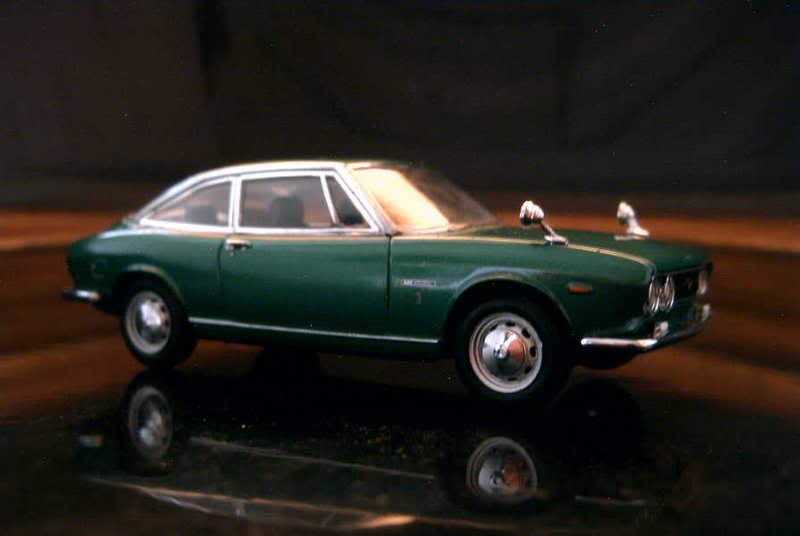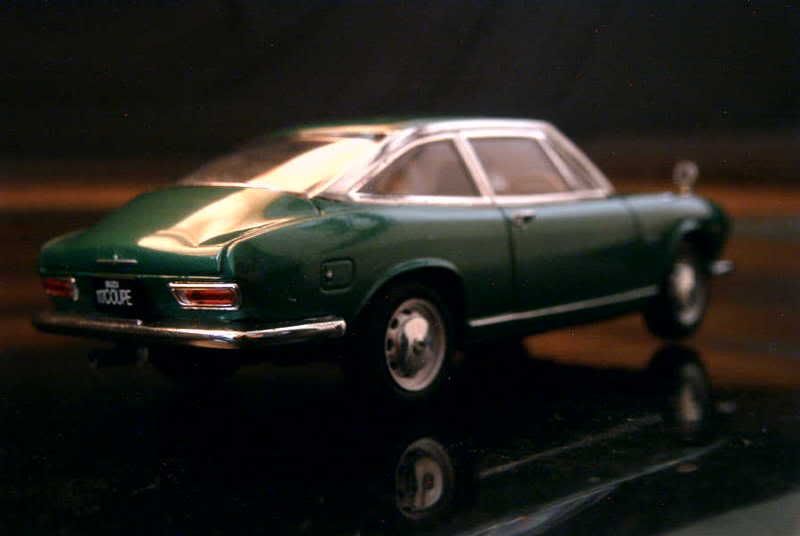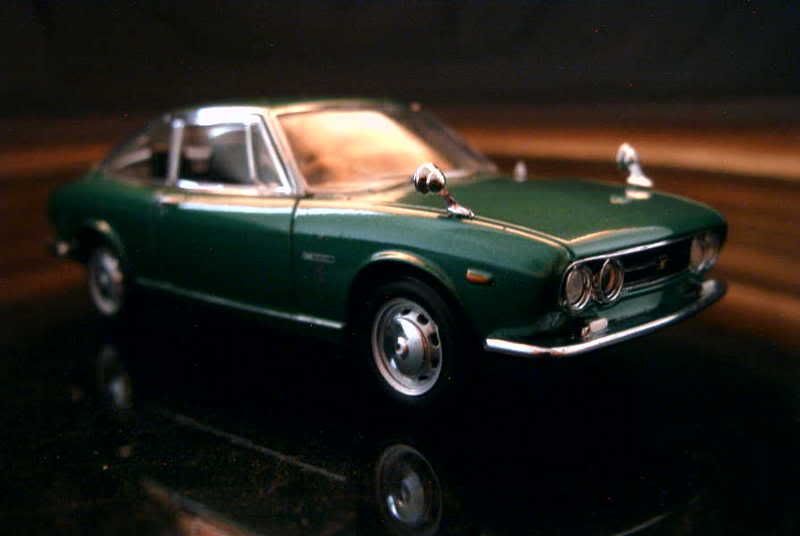After the Maserati Ghibli, let’s jump to another Giugiaro design of the era, the Isuzu 117.
A little history
By 1966, the Isuzu Bellel entered its fifth year in production. Though relatively elegant, and enjoying an optional diesel engine which made it quite attractive to fleet operators, the mid-sized car had proved to be a commercial flop. In 1965, an updated body also failed to push the sales upward. Time had come for a replacement.
The new car was known as the 117 among Isuzu’s engineers and designers. Nevertheless, when it was released for the 1967 model year, it bore the name Florian. As the Bellel before it, the new car was offered as either a four-door sedan or a station wagon. A third model was nonetheless on the way: a coupe that had already been shown to the public as early as spring 1966, during the Geneva motor show.
An exclusive vehicle exhibiting all of Isuzu’s know-how, the coupe, which unlike its two companions retained 117 as a name, was put into limited production during 1968. Built by hand with extreme care, fitted with posh appointments, the 117 retained the Florian’s platform but received a brand new 1.6-litre, dual overhead camshafts engine – a first in its country of origin. Positioning itself beyond any doubt out of the mainstream, the 117 shunned the convoluted styling that was typical of Japanese cars of the time, and received simple and graceful lines drawn for it by Ghia’s Giorgetto Giugiaro.
During its first years in production the 117 remained seldom seen on Japanese roads – Isuzu had wanted it this way. For the company’s flagship, the only raisons d’être were luxury and innovation – the 117 received the country’s first engine fed by electronic fuel injection, courtesy of Bosch, in 1970.
All this changed in 1971. American giant General Motors, eying on the growing Japanese market, signed an agreement with Isuzu and, all of a sudden, low-volume, exclusive vehicles produced for corporate image were crossed out of the company’s agenda. To keep its place among Isuzu’s models, the 117 had to sell in much larger quantities. A new 1800 N, simpler and much cheaper, was immediately introduced. Yearly production could have been previously counted in hundreds; from then on it was a four-digit figure.
The later life of the 117 isn’t its happier time. Cost-cutting policies and the decade’s obsession with plastic signed the death warrant of the original marquetry. For its tenth model year in production, the 117 received an uncanny facelift – to say the truth, it was probably welcomed back then as the car’s body clearly showed the signs of an advancing age, but today’s car enthusiast can only favour the original lines traced in Italy during the Sixties. Finally, the 117 received an optional 2.2-litre diesel engine, a disgrace for a vehicle born as a sports car. The agony finally ended in 1981, when Isuzu released the 117’s long awaited successor, the striking Piazza.
About the model
Model: Isuzu 117
Year: 1968
Maker: Ebbro
Scale: 1/43
Distributed by: Ebbro, "Oldies" series ref. 43620
Acquired: brand new, in December 2006, in Hong Kong, S.A.R.
I was recently reading on a forum from someone putting Ebbro in the same league as Ixo or Vitesse, and below Minichamps and Auto Art in terms of quality. I do not share this opinion, and this particular model is a testimony to the fact that Ebbro models are indeed as good as Minichamps' ones. The 117, as it appeared when first released, is flawlessly rendered by the Japanese maker, which well deserves a 15/20 rating for its efforts.



A little history
By 1966, the Isuzu Bellel entered its fifth year in production. Though relatively elegant, and enjoying an optional diesel engine which made it quite attractive to fleet operators, the mid-sized car had proved to be a commercial flop. In 1965, an updated body also failed to push the sales upward. Time had come for a replacement.
The new car was known as the 117 among Isuzu’s engineers and designers. Nevertheless, when it was released for the 1967 model year, it bore the name Florian. As the Bellel before it, the new car was offered as either a four-door sedan or a station wagon. A third model was nonetheless on the way: a coupe that had already been shown to the public as early as spring 1966, during the Geneva motor show.
An exclusive vehicle exhibiting all of Isuzu’s know-how, the coupe, which unlike its two companions retained 117 as a name, was put into limited production during 1968. Built by hand with extreme care, fitted with posh appointments, the 117 retained the Florian’s platform but received a brand new 1.6-litre, dual overhead camshafts engine – a first in its country of origin. Positioning itself beyond any doubt out of the mainstream, the 117 shunned the convoluted styling that was typical of Japanese cars of the time, and received simple and graceful lines drawn for it by Ghia’s Giorgetto Giugiaro.
During its first years in production the 117 remained seldom seen on Japanese roads – Isuzu had wanted it this way. For the company’s flagship, the only raisons d’être were luxury and innovation – the 117 received the country’s first engine fed by electronic fuel injection, courtesy of Bosch, in 1970.
All this changed in 1971. American giant General Motors, eying on the growing Japanese market, signed an agreement with Isuzu and, all of a sudden, low-volume, exclusive vehicles produced for corporate image were crossed out of the company’s agenda. To keep its place among Isuzu’s models, the 117 had to sell in much larger quantities. A new 1800 N, simpler and much cheaper, was immediately introduced. Yearly production could have been previously counted in hundreds; from then on it was a four-digit figure.
The later life of the 117 isn’t its happier time. Cost-cutting policies and the decade’s obsession with plastic signed the death warrant of the original marquetry. For its tenth model year in production, the 117 received an uncanny facelift – to say the truth, it was probably welcomed back then as the car’s body clearly showed the signs of an advancing age, but today’s car enthusiast can only favour the original lines traced in Italy during the Sixties. Finally, the 117 received an optional 2.2-litre diesel engine, a disgrace for a vehicle born as a sports car. The agony finally ended in 1981, when Isuzu released the 117’s long awaited successor, the striking Piazza.
About the model
Model: Isuzu 117
Year: 1968
Maker: Ebbro
Scale: 1/43
Distributed by: Ebbro, "Oldies" series ref. 43620
Acquired: brand new, in December 2006, in Hong Kong, S.A.R.
I was recently reading on a forum from someone putting Ebbro in the same league as Ixo or Vitesse, and below Minichamps and Auto Art in terms of quality. I do not share this opinion, and this particular model is a testimony to the fact that Ebbro models are indeed as good as Minichamps' ones. The 117, as it appeared when first released, is flawlessly rendered by the Japanese maker, which well deserves a 15/20 rating for its efforts.






No comments:
Post a Comment